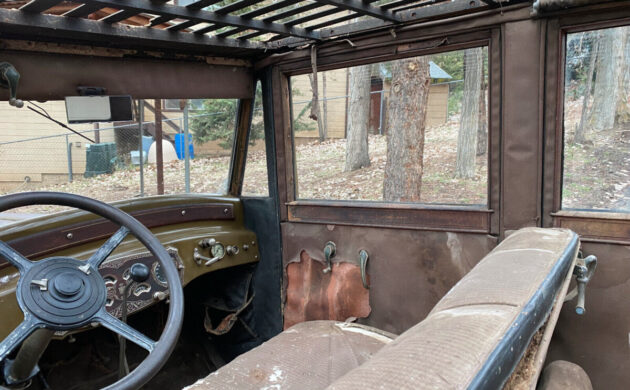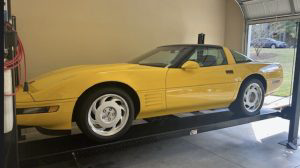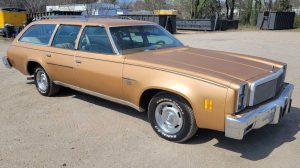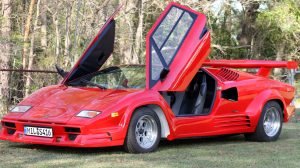Cadillacs of the mid-1920s were influenced by a new designer who left Stanford University to work at his father’s firm, Earl Automotive Works – Harley Earl. The family firm was purchased by Don Lee Cadillac, of Los Angeles. Earl was kept on at Don Lee and eventually found a berth at Cadillac itself. His famous Art and Color department established automotive design as a pursuit in its own right. Meanwhile, back in Hollywood, Don Lee was selling Cadillacs hand over fist to celebrities, and so he came to sell a 1927 model to a character named “Pop” Vern Ward. Ward ran Seminole Hot Springs – a celebrity hangout – but he was also apparently an accomplished tinkerer. He felt the big Cadillac was overpowered for its brakes, so he designed an elaborate air brake system for his new vehicle. Here on eBay is the product of at least one man’s passion, a 1927 Cadillac 314 Suburban with custom period air brakes bid to $10,000, no reserve, located in Frazier Park, California. The car has been parked since 1942 and judging from the seller’s ad, it definitely found the right person to usher it into a better life. We have T.J. to thank for this most unusual tip!
The seller acquired the car from a gentleman who in turn had wanted the car badly enough to pester the then-owner for years until he was able to buy it. Once you see the videos in the eBay ad, you will understand why this particular car has generated so much excitement. Not only is it exceptionally representative of its time and the people who owned it, but it’s also odd! The air brakes are an elaborate set-up involving lines, valves and reservoirs ponied off the engine, accompanied by rubber bladders and shims in the drum brakes themselves. The photo above shows the lines leading out of the head; this shot shows the other side of the engine bay where the valved passage collects air from all the lines to send it to canisters under the car. These are used as reservoirs, and the air pressure eventually makes its way into special rubber bladders that push against the drums to stop the car. The last video in the ad explains the process.
The current seller has done a yeoman’s job piecing together the history of this car and cleaning it up to show off its best features. The dash is elaborately filigreed; the window glass features interior shades. This model has a set of folding seats between the back of the driver’s set and the front of the rear set. It retains at least two AA Club of Southern California badges along with license plates from its registration for several years, which are hung together front and back. A new owner might consider stabilizing the interior to preserve its originality but for sure the roof will need attention.
The car comes with a spare 1928 Cadillac chassis should the new owner want to convert it back to conventional brakes. The period conversion has precedent, though: Westinghouse was selling air brake kits around the early 1930s at least. It might be a shame to put it back to “juice brakes”. I encourage readers to invest an hour of time to watch the videos in this ad; the seller does a wonderful job illustrating the provenance of this car. See if you agree that it should be kept as is.














It’s a strange ad. Why does the author indicate this 1927, sold in 1930 (which back then often became the ‘year’ on documentation, but I digress, because…) have air brakes “before hydraulic”? Walter P. Chrysler assured all cars sold had hydraulic brakes upon the companies inception (kinda… Maxwell didn’t) in 1926… Chrysler followed Duesenberg, which debuted hydraulic brake technology in 1921.
I’m not versed in 1927 Cadillacs, but what does Harley Earl have to do with this? Did he suggest that 3rd headlight be added?
The Earl connection at first seems tangential, in that his father’s coachbuilding firm was acquired by Don Lee, the Cadillac dealer who sold this car to the guy who fitted it with air brakes.
However, Earl likely had a hand in designing the body for this car, as luxury cars of this era (including Cadillac) were commonly only mass-produced as a running chassis alone, which would then be shipped to custom coachbuilders like the Earl/Don Lee shop, where a bespoke body would be designed and fabricated to the customer’s specifications. Series-production bodies for lesser marques were typically designed by engineers concerned primarily with function and cost but little regard for style.
Earl’s commission to design a stylish series-production body for the 1927 LaSalle — a then-new junior marque for Cadillac, to fill the market gap between Caddy and Buick — was a smash success that convinced GM president Walter Sloan to take body styling seriously, hiring Earl to head up a new Art and Color Section designing series-production bodies for all GM cars henceforth, kicking off a revolution for styling across the entire industry.
Earl was the designer working for Cadillac when this car was introduced. I could have made that more clear.
Hi Michelle,
Cadillac did not get hydraulic brakes until 1937, so I can see why the original owner would of updated to air brakes, hydraulic would of been an oddity. So to get it back to original it would end up with mechanical brakes, not hydraulic.
Thanks. I have a mental block on Cadillacs and hydraulic brakes – sheesh!
Sold USED in 1930 by Don Lee… no info or history known prior. Sweet car!
I expect the extra chassis is included because the seller knows it’s effectively impossible to rebuild the air brake system without fabricating most of the necessary parts.
Fascinating, Captain,( yep, no surprise I was an original Star Trek fan), worth the membership price alone. I never knew of an air brake application on cars. Tip of the hat to the author.
Brakes are an interesting topic. Air brakes in the 20s were nothing new. Trains had air brakes since the 1870s. Brakes weren’t an issue in early cars because their speed dictated design. Most weren’t much more than the stage coach lever rubbing a wooden block agin a wheel. I don’t think compressor technology allowed them to be used in a car. As mentioned, in the late teens, speed was increasing and a better system was needed. Ford disliked hydraulic brakes, and was the last to accept them in his cars. He believed mechanical brakes were safer and he wasn’t totally wrong. I didn’t watch the video, I’m a busy man( at 4 am) but it looks like the motor was used as the compressor, and looks pretty hoaky, but must have worked. Sadly, I don’t see a future for this grand old automobile, air brakes or not, time has passed for any interest.
Not hokey at all.
When timed right, a running engine makes a perfect air compressor.
Many times back on the farm where an air compressor would have been a real luxury, the old 4 cyl. Farmall would be running on three while the fourth would be pumping up a tire.
I remember well!
I turned eleven in 1961 when my uncle, a used car dealer, would take me to his lot on Saturdays and during school vacations. One of my jobs was to start the engine of a disabled 1949 Pontiac (a task that, incidentally, delighted me) and connect the hose of an air tank to a fitting that had been substituted for one of the spark plugs. Seems rather primitive, I admit. Yet many younger types might be genuinely surprised to learn the pace of life wasn’t always as rushed and anxiety-driven as it now is and that we managed to accomplish everything we need to but at a relaxed pace.
I worked with industrial portable air compressors, like the kind a jack hammer uses, and they were Ford V8s with a special cam, and one side would be for the air compressing and the other, essentially a 4 cylinder. to run it.
Regardless of the braking system the car has a very nice color combination and also an imposing bodywork.
It’s a Cadillac.
I have rebuilt the 1927 presidential limousine in the late seventies early ’80s I was very impressed with the technology from the 1927
Work that was put into the presidential limousine. I also own and Bancroft movie actress 1949 chauffeur driven 75 series limousine which I’ve had since 1976 and purchased it from her. So needless to say I enjoy the original better than something that was worked on and added at a later date.
I have rebuilt the 1927 presidential limousine in the late 70s early ’80s I was very impressed with the technology from the 1927
Work that was put into the presidential limousine. I also own and Bancroft movie actress 1949 chauffeur driven 75 series limousine which I’ve had since 1976 and purchased it from her. So needless to say I enjoy the original better than something that was worked on and added at a later date.
You can easily spend 50k to get this jalopy half concourse show ready or find a better one running for around 35k. But of course if you unlimited funds and 2 years to spare, it could be a show stopper.. that’s the problem with these barn finds.
JV – Smash Palace
Henry Ford was not wrong – early hydraulic lines and cylinders often broke – lines burst 3 times on my ’56 Chevy, fortunately the “emergency brake”, later renamed “parking brake”, would not only stop the car, but, you could modulate it. The dual master cylinder helped, as did sturdier brake lines. Air brakes allowed more pressure to be applied than non-power hydraulic brakes, but were equally prone to failure. What Westinghouse thought of was that the pressurizing part kept the brake shoe off the wheel, so, if it failed, the brakes were applied, and, eventually, the modern system, where the failsafe application still is present, but it also works in reverse to apply the brakes in a normal braking situation. So this Caddy must have had the dual system of a modern truck or bus, not complex, but more parts than a hydraulic system, let alone a mechanical system.
Very interesting car, but a lot of work to end up with a relatively undesirable model. I have a 1926 Cadillac, and can assure you that the original mechanical brakes are very effective at stopping these fairly heavy cars. Also, the fuel is delivered to the carburetor by an air compressor on the engine that pressurizes the tank to force the gas up.
Schramm air compressors had half the engine as the compressor, the other ran the motor. I’ve seen the with V-8’s but they probably had 4’s and 6’s too? Neat idea and the compressor
Still are still used by people who have them.
They had a building in West Chester PA
Jay Leno really should buy this car or consult. There is likely no one else that could be expected to tackle this air brake project.